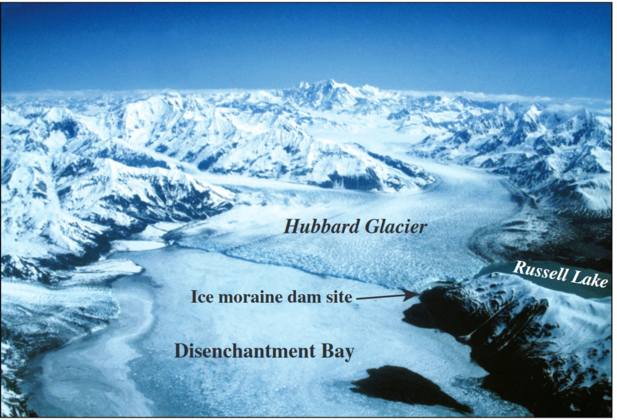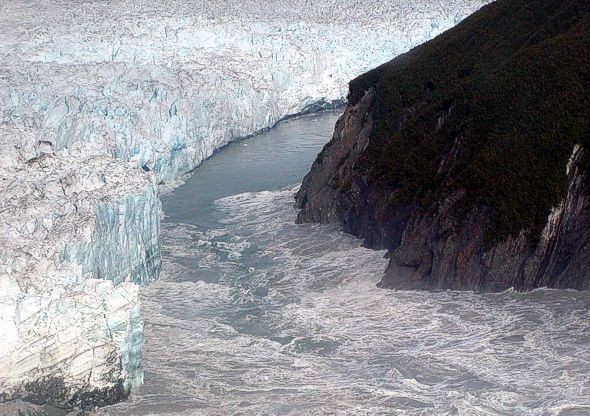Glacial lake outburst flood: Difference between revisions
m (1 revision imported: From the summer) |
energy>Jmdonev No edit summary |
||
| Line 1: | Line 1: | ||
[[Category:Done | [[Category:Done 2020-02-29]] | ||
<onlyinclude>'''Glacial lake outburst floods (GLOFs)''' are [[flood]]s that occur from an unstable natural dam formed from a [[glacier | glacial]] retreat.<ref name=RE4>”Managing the Risks of Extreme Events and Disasters to Advance Climate Change Adaptation", Intergovernmental Panel on Climate Change, New York, 2012.</ref> </onlyinclude> Glaciers are dynamic bodies of ice that change frequently.<ref name=RE3>"Hazards - Glaciers, Climate, and Society", Glaciers.uoregon.edu, 2016. [Online]. Available: http://glaciers.uoregon.edu/hazards.html. [Accessed: 20- May- 2016].</ref> When a glacier retreats, it can leave behind a large impression in the ground that fills with [[water]], turning it into a lake. This is typically known as a moraine.<ref name=RE4/> These lakes can be impounded by an unstable pile of debris and buried ice.<ref name="RE2”>”Glacial lake outburst flood (GLOF)", Swisseduc.ch, 2016. [Online]. Available: http://www.swisseduc.ch/glaciers/glossary/glof-2-en.html. [Accessed: 23- May- 2016].</ref> As the [[climate]] warms, glaciers generally shrink. In many mountains such as the Andes, | <onlyinclude>'''Glacial lake outburst floods (GLOFs)''' are [[flood]]s that occur from an unstable natural [[dam]] formed from a [[glacier | glacial]] retreat.<ref name=RE4>”Managing the Risks of Extreme Events and Disasters to Advance Climate Change Adaptation", Intergovernmental Panel on Climate Change, New York, 2012.</ref> </onlyinclude> Glaciers are dynamic bodies of [[ice]] that change frequently.<ref name=RE3>"Hazards - Glaciers, Climate, and Society", Glaciers.uoregon.edu, 2016. [Online]. Available: http://glaciers.uoregon.edu/hazards.html. [Accessed: 20- May- 2016].</ref> When a glacier retreats, it can leave behind a large impression in the ground that fills with [[water]], turning it into a lake. This is typically known as a [[moraine]].<ref name=RE4/> These lakes can be impounded by an unstable pile of debris and buried ice.<ref name="RE2”>”Glacial lake outburst flood (GLOF)", Swisseduc.ch, 2016. [Online]. Available: http://www.swisseduc.ch/glaciers/glossary/glof-2-en.html. [Accessed: 23- May- 2016].</ref> As the [[climate]] warms, glaciers generally shrink. In many mountains such as the Andes, Himalayas, Alps, Rockies, and elsewhere, the retreat of glacier tongues sometimes allows unstable moraine dammed lakes to form.<ref name=RE3/> Terminal moraines act as [[dam]]s for these lakes, but as the lakes swell from rising water levels and the retreating glacial ice tongue, the moraine dam can weaken. Moraine dams that become too weak may crumble under too much pressure from the swelling lake, creating a GLOF. If the moraine dams of a glacial lake fail, the water can burst out, leading to massive floods and debris flows with potentially extensive damage downstream, including loss of life and infrastructure.<ref name="RE1">"Glacial Lakes and Glacial Lake Outburst Floods in Nepal", The International Centre for Integrated Mountain Development, 2011. [Online]. Available: http://www.icimod.org/dvds/201104_GLOF/reports/final_report.pdf. [Accessed: 24- May- 2016].</ref> Alternatively, and more commonly, glacial ice from the retreating glacier can crash into lakes, generating giant waves that erode weak moraine dams in a matter of minutes, thereby also triggering GLOFs.<ref name=RE3/> | ||
<gallery caption="Glacial lake outburst flood in Alaska" mode=packed heights=280px> | <gallery caption="Glacial lake outburst flood in Alaska" mode=packed heights=280px> | ||
| Line 8: | Line 8: | ||
File:Hubbard_Glacier_August_14.2002.jpg|<ref name =USGS/> | File:Hubbard_Glacier_August_14.2002.jpg|<ref name =USGS/> | ||
</gallery> | </gallery> | ||
In the summer of 2002 Alaska's Hubbard glacier pinched off the connection between Russel Fjord and Disenchantment bay. This made the Russel Fjord into a glacial lake, for a short period of time. The lake rose 15 m above sea level. When the lake burst, it sent almost 2 million cubic feet of water per second back into the bay.<ref name =USGS/> | In the summer of 2002 Alaska's Hubbard glacier pinched off the connection between Russel Fjord and Disenchantment bay. This made the Russel Fjord into a glacial lake, for a short period of time. The lake rose 15 [[meter|m]] above sea level. When the lake burst, it sent almost 2 million [[cubic feet]] of water per [[second]] back into the bay.<ref name =USGS/> | ||
In the past century, GLOFs have caused disasters in high mountain regions of the world which include the Andes, areas in Caucasus and Central Asia, the Himalayas, North America and the European Alps.<ref name=RE4/> There are many examples in Nepal in which loss of lives and property have occurred as a result of glacial lake outburst floods.<ref name=RE1/> Glaciers, being ice sheets, can indicate increased [[air]] [[temperature]] due to being sensitive to [[climate change]].<ref name=RE1/> Glacial lakes are not only a risk of potential danger, but they are also an important natural resource, providing a [[fresh water]] source for people.<ref name=RE1/> Over the past 20-30 years, human measures to mitigate unstable glacier lakes in the Himalaya and European Alps may have prevented some potential GLOF disasters.<ref name=RE4/> Research has shown that due to global climate change and retreating glaciers, there is an escalated risk in GLOFs worldwide.<ref name=RE3/> This is leading glacial lakes to swell and increase the risk of flooding. For example, in Bhutan, a region with 677 glaciers and 2,794 glacial lakes has | In the past century, GLOFs have caused disasters in high mountain regions of the world which include the Andes, areas in Caucasus and Central Asia, the Himalayas, North America and the European Alps.<ref name=RE4/> There are many examples in Nepal in which loss of lives and property have occurred as a result of glacial lake outburst floods.<ref name=RE1/> Glaciers, being ice sheets, can indicate increased [[air]] [[temperature]] due to being sensitive to [[climate change]].<ref name=RE1/> Glacial lakes are not only a risk of potential danger, but they are also an important natural resource, providing a [[fresh water]] source for people.<ref name=RE1/> Over the past 20-30 years, human measures to mitigate unstable glacier lakes in the Himalaya and European Alps may have prevented some potential GLOF disasters.<ref name=RE4/> Research has shown that due to global climate change and retreating glaciers, there is an escalated risk in GLOFs worldwide.<ref name=RE3/> This is leading glacial lakes to swell and increase the risk of flooding. For example, in Bhutan, a region with 677 glaciers and 2,794 glacial lakes, has experienced more than 21 glacial lake outburst floods in the last two centuries.<ref name=RE1/> From the 21 mentioned, 4 of the outbursts have occurred in the last 40 years.<ref name=RE1/> GLOFs are quite rare, which makes exact statistics about them difficult. Climate change is expected to significantly increase the number of GLOFs in the coming decades, although the number hasn't increased yet.<ref>"Climate change and the global pattern of moraine-dammed glacial lake outburst floods" by Harrison et al, available here: https://www.the-cryosphere.net/12/1195/2018/ Accessed February 18th, 2020.</ref> Climate change is causing significant [[glacial retreat]], which is expected to continue in coming decades. | ||
Below is a video explaining climate change impacts and the risks associated with glacial lake outburst floods in regions of the Himalayas. [http://karakoram.co/portfolio/science/ For more information:] | Below is a video explaining climate change impacts and the risks associated with glacial lake outburst floods in regions of the Himalayas. [http://karakoram.co/portfolio/science/ For more information:] | ||
| Line 17: | Line 17: | ||
<iframe width="760" height="455" src="https://www.youtube.com/embed/T-AAm0w-KjA" frameborder="0" allowfullscreen></iframe> | <iframe width="760" height="455" src="https://www.youtube.com/embed/T-AAm0w-KjA" frameborder="0" allowfullscreen></iframe> | ||
</html> | </html> | ||
== For Further Reading == | |||
For further information please see the related pages below: | |||
*[[Glacier]] | |||
*[[Glacial and interglacial periods]] | |||
*[[Climate change]] | |||
*[[Ice age]] | |||
*Or explore a [[Special:Random| random page]] | |||
==References== | ==References== | ||
{{reflist}} | {{reflist}} | ||
[[Category: Uploaded]] | |||
Revision as of 22:57, 18 February 2020
Glacial lake outburst floods (GLOFs) are floods that occur from an unstable natural dam formed from a glacial retreat.[1] Glaciers are dynamic bodies of ice that change frequently.[2] When a glacier retreats, it can leave behind a large impression in the ground that fills with water, turning it into a lake. This is typically known as a moraine.[1] These lakes can be impounded by an unstable pile of debris and buried ice.[3] As the climate warms, glaciers generally shrink. In many mountains such as the Andes, Himalayas, Alps, Rockies, and elsewhere, the retreat of glacier tongues sometimes allows unstable moraine dammed lakes to form.[2] Terminal moraines act as dams for these lakes, but as the lakes swell from rising water levels and the retreating glacial ice tongue, the moraine dam can weaken. Moraine dams that become too weak may crumble under too much pressure from the swelling lake, creating a GLOF. If the moraine dams of a glacial lake fail, the water can burst out, leading to massive floods and debris flows with potentially extensive damage downstream, including loss of life and infrastructure.[4] Alternatively, and more commonly, glacial ice from the retreating glacier can crash into lakes, generating giant waves that erode weak moraine dams in a matter of minutes, thereby also triggering GLOFs.[2]
- Glacial lake outburst flood in Alaska
In the summer of 2002 Alaska's Hubbard glacier pinched off the connection between Russel Fjord and Disenchantment bay. This made the Russel Fjord into a glacial lake, for a short period of time. The lake rose 15 m above sea level. When the lake burst, it sent almost 2 million cubic feet of water per second back into the bay.[5]
In the past century, GLOFs have caused disasters in high mountain regions of the world which include the Andes, areas in Caucasus and Central Asia, the Himalayas, North America and the European Alps.[1] There are many examples in Nepal in which loss of lives and property have occurred as a result of glacial lake outburst floods.[4] Glaciers, being ice sheets, can indicate increased air temperature due to being sensitive to climate change.[4] Glacial lakes are not only a risk of potential danger, but they are also an important natural resource, providing a fresh water source for people.[4] Over the past 20-30 years, human measures to mitigate unstable glacier lakes in the Himalaya and European Alps may have prevented some potential GLOF disasters.[1] Research has shown that due to global climate change and retreating glaciers, there is an escalated risk in GLOFs worldwide.[2] This is leading glacial lakes to swell and increase the risk of flooding. For example, in Bhutan, a region with 677 glaciers and 2,794 glacial lakes, has experienced more than 21 glacial lake outburst floods in the last two centuries.[4] From the 21 mentioned, 4 of the outbursts have occurred in the last 40 years.[4] GLOFs are quite rare, which makes exact statistics about them difficult. Climate change is expected to significantly increase the number of GLOFs in the coming decades, although the number hasn't increased yet.[6] Climate change is causing significant glacial retreat, which is expected to continue in coming decades.
Below is a video explaining climate change impacts and the risks associated with glacial lake outburst floods in regions of the Himalayas. For more information:
For Further Reading
For further information please see the related pages below:
References
- ↑ 1.0 1.1 1.2 1.3 ”Managing the Risks of Extreme Events and Disasters to Advance Climate Change Adaptation", Intergovernmental Panel on Climate Change, New York, 2012.
- ↑ 2.0 2.1 2.2 2.3 "Hazards - Glaciers, Climate, and Society", Glaciers.uoregon.edu, 2016. [Online]. Available: http://glaciers.uoregon.edu/hazards.html. [Accessed: 20- May- 2016].
- ↑ ”Glacial lake outburst flood (GLOF)", Swisseduc.ch, 2016. [Online]. Available: http://www.swisseduc.ch/glaciers/glossary/glof-2-en.html. [Accessed: 23- May- 2016].
- ↑ 4.0 4.1 4.2 4.3 4.4 4.5 "Glacial Lakes and Glacial Lake Outburst Floods in Nepal", The International Centre for Integrated Mountain Development, 2011. [Online]. Available: http://www.icimod.org/dvds/201104_GLOF/reports/final_report.pdf. [Accessed: 24- May- 2016].
- ↑ 5.0 5.1 5.2 5.3 5.4 USGS (Accessed September 3rd, 2016) [Online], Available: http://pubs.usgs.gov/fs/fs-001-03/
- ↑ "Climate change and the global pattern of moraine-dammed glacial lake outburst floods" by Harrison et al, available here: https://www.the-cryosphere.net/12/1195/2018/ Accessed February 18th, 2020.





